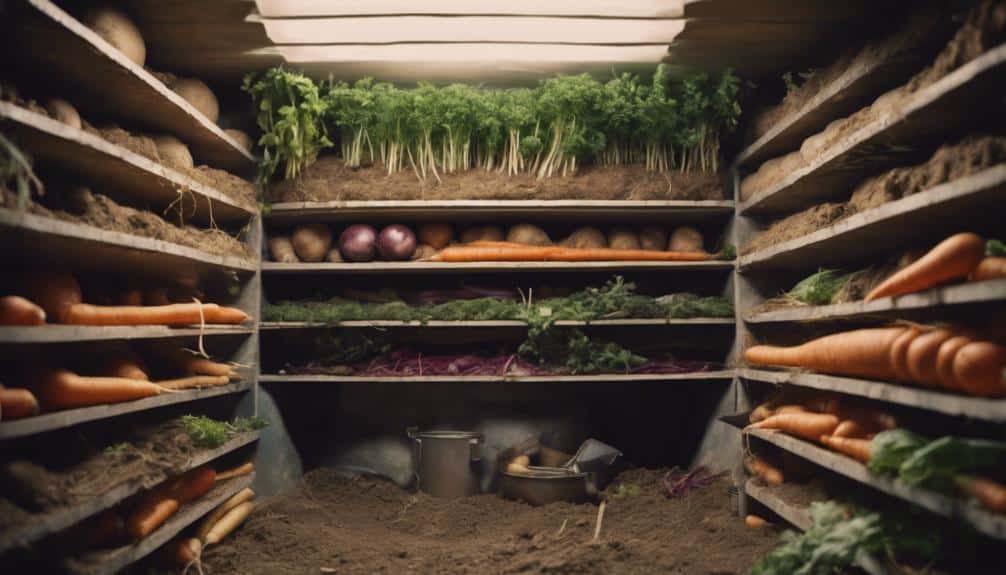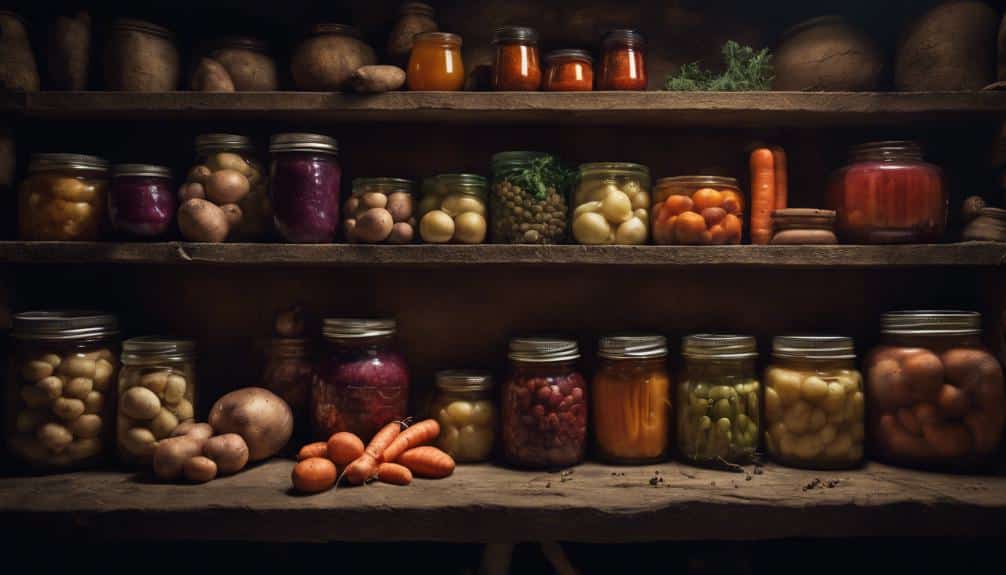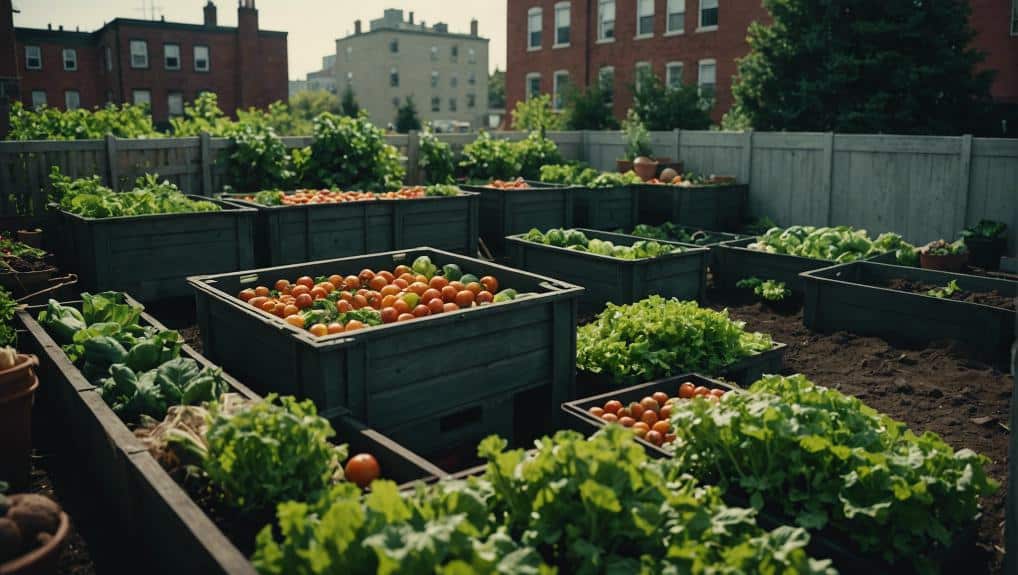To set up a root cellar in your urban homestead, first choose a location protected from direct sunlight—either above-ground or partially buried. Build a wooden frame and use insulated panels to maintain the required 32-40°F and 85-95% humidity.
Make sure your root cellar has a well-sealed door and a simple ventilation system with an intake and exhaust vent for proper air circulation. Dirt floors are ideal as they naturally regulate moisture and temperature.
Water-proofing with a membrane and French drains will keep moisture out and preserve your harvest. Exploring these elements further will reveal more insights into maintaining an efficient urban root cellar.
Canning and preserving your urban garden produce is an essential practice for a better homestead. Also read this guide to know how you can benefits from attracting some insects to your garden.
Requirements for a root cellar

To establish a functional root cellar, you need a cool, humid, and well-ventilated space. It’s vital to keep your veggies fresh and your spirit of self-sufficiency thriving. You’re looking for a spot that stays between 32-40°F (0-4°C) with about 85-95% humidity. This balance prevents your produce from freezing while keeping it crisp and delaying spoilage.
You’ll also need to make sure the space is well-ventilated to avoid any buildup of gases released by the stored produce. Proper air circulation is important for maintaining the right temperature and humidity levels and can help ward off any potential rot. This is where you harness your independence, controlling the environment to suit your needs.
Insulating walls with straw bales or rigid foam can help maintain the necessary coolness. However, make sure these materials don’t compromise the ventilation.
Step by step guide to build a urban root cellar
Now that you’re ready to build your urban root cellar, let’s focus on the key elements to get it right.
First, you’ll need to decide if your root cellar will be above-ground or partially buried, which impacts both accessibility and temperature control.
Below we’ll cover the best flooring options to maintain proper humidity levels and explore effective ventilation techniques to keep air circulating and water out.
Root cellar above-ground?
Building an above-ground root cellar in an urban setting can be a straightforward project if you follow these step-by-step instructions.
First, you’ll need to choose a location that’s shielded from direct sunlight. Ideally, pick a north-facing wall of your house or garage.
Start by constructing a wooden frame; think of it as building a small shed. Use insulated panels for walls to maintain a stable temperature inside.
The door should be well-sealed to keep out warm air and pests. For ventilation, install a simple vent at the top and bottom of the structure. This setup allows cool air to enter from below and warm air to escape from the top, keeping your produce fresh without needing to dig underground.
Best floor for root celar
When deciding on the best floor for your urban root cellar, you might wonder if a dirt floor is a suitable choice.
Dirt floors maintain a naturally low temperature and high humidity, which are ideal conditions for storing most root vegetables.
You’ll also find that they’re relatively easy to install compared to other flooring options.
Is dirt floor good?
Considering a dirt floor for your urban root cellar can offer several benefits, including natural humidity control and cost-effectiveness.
It’s excellent for maintaining the cool, moist environment ideal for storing produce.
You’ll also dodge the expense and hassle of installing more elaborate flooring. this simple, sustainable choice can give you the freedom to focus on what truly matters: self-sufficiency and living on your own terms.
Ventilation for root celar
To guarantee proper air circulation in your urban root cellar, you’ll need to install a well-designed ventilation system. This setup guarantees that your stored produce remains fresh, preventing any buildup of harmful gases or excess humidity that could spoil your harvest.
Here’s what you should focus on:
- Airflow: Design the system to allow cool air in at the bottom and warm air out at the top.
- Intake and Exhaust Vents: Position these strategically to create a natural flow of air.
- Adjustable Covers: Have the ability to control vent openings based on seasonal needs.
This freedom to adjust your cellar’s climate gives you the upper hand in maintaining a favorable environment for your food storage.
Keeping water out
After confirming that your root cellar has adequate ventilation, it’s equally crucial to focus on waterproofing methods to keep moisture at bay. Start by applying a waterproof membrane along the exterior walls. This acts as a barrier against water seepage. Make sure the membrane covers the entire surface and overlaps at the seams for a tight seal.
Installing French drains around the perimeter is a good idea. These collect and redirect groundwater away from your cellar, preventing any potential water damage.
Dig a trench around the cellar, lay a perforated pipe, and cover it with gravel. Ensure it slopes away from the structure for effective drainage.
Check your cellar after heavy rains to address any leaks early. Regular maintenance keeps your storage free from moisture, safeguarding your harvest.
Cost to build a root cellar
Building a root cellar can vary in cost, typically depending on size and materials, but you should expect to invest at least $200 to $15 000 on avarage. The price can quickly escalate based on certain choices you make regarding construction and design. To help you navigate the financial aspect, here’s what greatly influences the cost:
- Materials: Opting for pre-cast concrete sections can be more expensive than using cinder blocks and waterproofing them yourself.
- Size: A larger cellar requires more materials and possibly more complex engineering, which raises the price.
- Location: If excavation is difficult due to rocky soil or the water table is high, costs for preparation and construction can increase.
| Root Cellar Type | Cost Range |
|---|---|
| Above-Ground | $200 – $25,000 |
| Below-Ground | $10,000 – $55,000 |
| Basement | $10,000 – $25,000 |
| Garage Floor | $3,000 – $9,000 |
| FEMA Safe Room/Storm Shelter | Up to 75% of total cost |
You’re not just buying a space to store your harvest; you’re investing in your independence from commercial systems.
The freedom to access fresh, stored food right from your backyard or under your house is invaluable. While the upfront cost might seem steep, consider it against the ongoing savings on your grocery bills.
Inexpensive root cellar alternatives

While building a root cellar might be costly, there are several budget-friendly alternatives you can explore to store your produce effectively.
One simple solution is using old refrigerators or freezers. You can often find these for free or very cheap when someone upgrades their kitchen appliances. Place them in a shady, cool area of your yard.
Another low-cost option is to bury garbage cans or food-grade barrels. Simply dig a hole deep enough so that the top of the container is at ground level, then fill it with your produce. Cover with a secure lid and insulate with straw or leaves to protect from freezing temperatures.
Consider utilizing your existing spaces like closets or basements for temporary storage. These areas, especially if they’re cooler and not prone to large temperature swings, can be great makeshift root cellars.
| Method | Description |
|---|---|
| Old Refrigerators | Use in shaded area, great for various vegetables and fruits. |
| Buried Containers | Bury garbage cans or barrels, cover with lid and insulate. |
| Utilize Existing Space | Convert closets or similar spaces into storage areas during the cooler months. |
These alternatives provide the freedom to store your harvest without a hefty investment.
Basement vs a root cellar
Many urban homesteaders often wonder whether to use their basement as a root cellar or to construct a separate one. If you’re aiming for independence and self-sufficiency, this decision can greatly impact your homesteading capabilities.
Using your existing basement has some clear advantages:
- Lower Costs: You’re already paying for your home; utilizing the basement means no additional structure is needed.
- Ease of Access: It’s easier to reach for daily or frequent use.
- Controlled Environment: You can better control temperature and humidity compared to an outside structure.
However, creating a dedicated root cellar can provide specialized conditions that might be hard to achieve in a basement. In a separate root cellar, you can design specifically for ideal storage conditions, which mightn’t be feasible in your basement due to its existing layout and usage.
Most important thing practicality of converting your basement versus building a new structure. Think about the long-term benefits and constraints each option presents, keeping in mind your goals and the unique conditions of your urban space.
Thing you can store in a root celar

Now that you’ve decided between using your basement or creating a separate root cellar, let’s explore what you can store in it.
Root cellars are ideal for storing a variety of fruits and vegetables that thrive in cool, humid conditions. You can keep apples, pears, and quinces, which are perfect for extending the freshness of your harvest. Root vegetables like carrots, beets, and potatoes also fare well, maintaining their crispness and flavor.
Don’t forget about your winter squashes such as butternut, acorn, and spaghetti squashes, which can last well into the winter months when stored correctly. Onions and garlic also benefit from the stable temperatures, keeping them firm and flavorful for cooking.
For those of you who love fresh leafy greens, consider bunching greens like kale and Swiss chard, which can be stored for short periods under the right conditions. You can also hang cured meats and sausages, which benefit from the cool air, enhancing their aging process.
What not to store in a root cellar
Understanding what not to store in your root cellar is essential for maintaining the quality and safety of your food. You’ve taken the step to embrace self-sufficiency, so ensuring that everything in your root cellar contributes to your independence is key. There are certain items that simply don’t belong in the cool, moist environment of a root cellar, as they can spoil or affect the storage life of other produce.
Here’s a quick list of what you should avoid:
- Ethylene-producing fruits: Such as apples and bananas. These can cause other fruits and vegetables to ripen too quickly.
- Odorous items: Onions and garlic, for example, which can impart their strong smells onto other stored goods.
- High-moisture content items: Avoid storing fresh milk, cheeses, or other dairy products as they can spoil and lead to mold.
Storing items improperly not only wastes your efforts but could also compromise your food independence. Make sure you’re not inadvertently shortening the shelf life of your hard-earned produce by keeping unsuitable items out of your root cellar.
How to simulate a root cellar

While you avoid storing certain items in your root cellar, you might wonder how to create one in an urban environment. It’s definitely possible to simulate a root cellar even if you don’t have the traditional space. You’ll need to think creatively and use what you’ve got to maintain the right environment for storing your harvest.
First, find a cool, dark, and slightly humid spot in your home. Basements are ideal, but a corner of a garage or an insulated closet can work too. You’re aiming for temperatures between 32-40°F (0-4°C) and humidity around 85-95%. If you can’t naturally achieve these conditions, you might need to add a small humidifier or a portable air conditioner adjusted to low temperatures.
Next, insulate the space to stabilize temperature fluctuations. Foam board or fiberglass insulation works well. Cover the walls and ceiling, and make sure to seal any gaps where air might leak.
Frequently Asked Questions
Can Root Cellars Be Built in Areas With High Water Tables?
Yes, you can construct root cellars in areas with high water tables, but it’s trickier. You’ll need to guarantee proper waterproofing and drainage to protect your stored goods from moisture.
Consider installing a sump pump or using water-resistant materials like concrete with a waterproof sealant. Elevating the floor above the water table level can also help.
Always check local water table levels and seek expert advice tailored to your specific location.
Are Root Cellars Safe During Earthquakes or Severe Weather?
Typically, they’re quite sturdy due to their underground construction, which naturally offers some protection.
However, their safety can vary based on how well they’re built and the local geological conditions. It’s important to reinforce them and consider seismic-resistant designs if you’re in an earthquake-prone area.
Always check local building codes to make sure your root cellar meets safety standards.
How Do Root Cellars Impact Property Value?
It can increase value by adding unique storage space that’s energy-efficient and environmentally friendly.
If you’re in an area where such features are prized, it could be a strong selling point. However, the actual impact varies by market and buyer interest.
It’s wise to research local trends and perhaps consult a real estate expert before making significant investments.
What Are the Legal Permits Required for Constructing a Root Cellar?
To construct a root cellar, you’ll need specific legal permits, which vary by location. Start by checking with your local building department to understand zoning laws and building codes.
You’ll likely need a building permit, and if you’re in a historic district or homeowner association, additional approvals may be required. It’s crucial to make sure your project complies with all local regulations to avoid fines and guarantee your cellar is safe and legal.
Can Root Cellars Be Made Accessible for Persons With Disabilities?
Yes, you can make root cellars accessible for individuals with disabilities. Begin by guaranteeing the entrance is wide enough for wheelchair access, ideally with a door width of at least 36 inches.
Install a ramp with a gentle slope instead of steps, and consider the interior layout to allow ample turning space. Non-slip flooring and handrails are essential for safety.
Additionally, make sure that shelving is reachable from a seated position.
